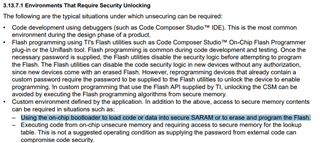Other Parts Discussed in Thread: C2000WARE
Tool/software:
Hi experts:
My customers' code consists of ASIL B code and common code(that means it has no safety function requirement). They want to put both parts of code in 280049, and want to achieve basic goal is that, common code can't change the ram, flash and peripherals register value belongs to ASIL B code;
I suggest them to use DCSM to achieve this goal, but there need you to help me double check some information, assume that I place ASIL B code in Zone1 and common code in Zone2
1. If Zone2 code want to modify the value in zone1 ram and flash, it will return 0x00;
2. If Zone2 code want to modify the value in zone1 ram and flash, it will be block; If you need to do that(such as OTA), you need to unlock the zone using function DCSM_unlockZone1CSM(&psCMDKey) before.

3. Can DCSM protect the peripherals register? That means, if zone1 use PWM1, zone2 can't modify PWM1 related register.
4. Can DCSM realize the below function: For example, CPU can access LS0RAM, but DMA can't access LS0RAM, that seems it make sure only host can access specified memory range. If DCSM can't, is it exist other module in 280049 to realize this function?
I'm looking forward to your reply, thank you!
Best Regards
Shuqing Zhou (Sunny Zhou)






